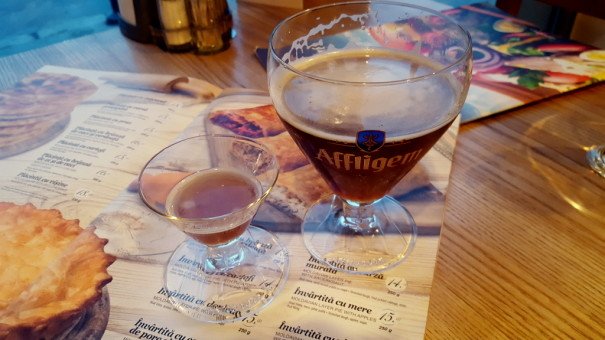
There’s No Better Way to Drink Than Like a Transylvanian Saxon

There’s No Better Way to Drink Than Like a Transylvanian Saxon
Affligem in Bucharest
We’re in a pie place in Bucharest. The walls are covered with wooden kitchen utensils and stuffed chicken dolls with button eyes and the servers are dressed in white aprons with frills along the seams. It’s the best place in the city for pie, we’ve been told, pies that aren’t cherry or lemon meringue but pies that are filled with warm, savory meats and fresh cheeses. All around us, everybody is yammering away in Romanian and seems to know exactly how many small dishes to order. Everybody’s table is full of tiny round plates and crumpled napkins.
Our server, a young woman whose name tag says “Nina,” brings out a flat, round serving platter with a sheep- and goat-cheese pie, a Greek salad, and four full glasses on it. She sets the platter down on the edge of the wooden table and presents us with what we recognize first: two tulip-shaped beer glasses, filled to the brim with a deep golden-colored blonde ale and topped with light, foamy bubbles. Then, she sets down the two thumb-sized chalice glasses, the pie, and the salad.
My husband and I look at each other. What’s in the little glass, and what are we supposed to do with it?
Nina senses the pause. “It’s, like, the body and the soul,” she says, pointing at the tulip and then at the chalice. “We pay attention to the soul in Romania.”
We toast, we sip, and we think. It’s thicker, more like sweet bananas and yeast, smooth and grainy. It evokes the taste of bread.
As I’d come to learn, what we were actually drinking was Affligem, a Belgian brew inspired by the 1,000 year old Benedictine tradition of serving the yeast, the “soul” of the beer, in its own small glass. The idea is that the yeast—the magic ingredient that drives the fermentation process creation of beer—is its own delicacy, its own piece of the process worth celebrating. As it sinks, working its way down, it delicately enhances the flavor profile of the beer and finally clumps into a pile at the bottom. Instead of swirling it back in, however, the beer is served without it—as a bright, crisp, and clean lager—and the part at the bottom becomes a drink all its own, a viscous, sedimented testament to the life force of something greater. Though not everyone serves Affligem this way, the Transylvanian Saxons did, so it’s still the way today.
We pay attention to the soul in Romania.
A week before we boarded the plane for Romania, I had walked out of a job I hated for the very last time, the last heavy box of books in my arms. My first professor job, at a place I’d hoped to thrive in, was over. In the heat of the May summer on top of the mountain where the university was, no one said goodbye to me. As I drove over the mountain, I blasted the playlist I’d made of songs about bad jobs and cried.
Bucharest was the first stop of a two-week trip through Eastern Europe, a place that would come to represent a moment in my life characterized by the admittance of defeat and uncertainty. For the first time in my life, I had learned to say enough was enough. After this trip, we’d pack up all of our belongings again and move 3,000 miles away. We’d start over again, and we’d thrive.
Though there are three common ways of serving Affligem, I like Romania’s tradition. I like the idea of sipping the life force of a beer out of a tiny chalice. A tiny, thumb-sized chalice, a centuries-old tradition, where the discarded becomes the focus, where that which we pay no attention finally garners its much-deserved spotlight.